There's nothing quite like the feeling of a sharp, gleaming knife in your hand as you prepare a delicious meal. However, as time goes on, even the best knives can fall victim to the relentless march of rust. Rust not only dulls your blades but also poses health risks as it can contaminate your food. If you've ever pondered the solution to banishing that troublesome rust and bringing your knives back to their original splendor, you're in the right spot.
But fear not. In this guide, we will rescue your knives from the clutches of rust and bring back their sharp, gleaming beauty. So, if you're tired of struggling with rusty knives or simply want to ensure the longevity of your kitchen tools, read on.
6 Methods To Clean Rust Off Of Knife
Removing Rust With Baking Soda

The sodium bicarbonate found in baking soda is useful in removing rust spots, and it's best in scenarios where you're dealing with light to moderate rust. It naturally has an abrasive texture but also neutralizes the acid compounds found in rust. This greatly facilitates the removal of rust stains when using the baking soda method.
- Prepare a baking soda paste by mixing a small quantity of water and baking soda in a small bowl.
- Spread a generous layer of this thick paste onto the knife.
- Utilize a soft cloth or a small brush to massage the paste into the areas with rust gently. If necessary, you can use steel wool to rub the baking soda onto the knife blade. However, steel wool can scratch the steel, so be careful and avoid using it on light rust stains.
- Wipe the entire blade clean, wash with dish soap, and dry fully with a towel before storing.
When using baking soda, it's important to mix a paste with a little water, apply it to the rusted areas, and then scrub gently with a toothbrush or sponge. After scrubbing, thoroughly rinse and dry the knife to prevent further rusting.
Removing Rust With A Rust Eraser
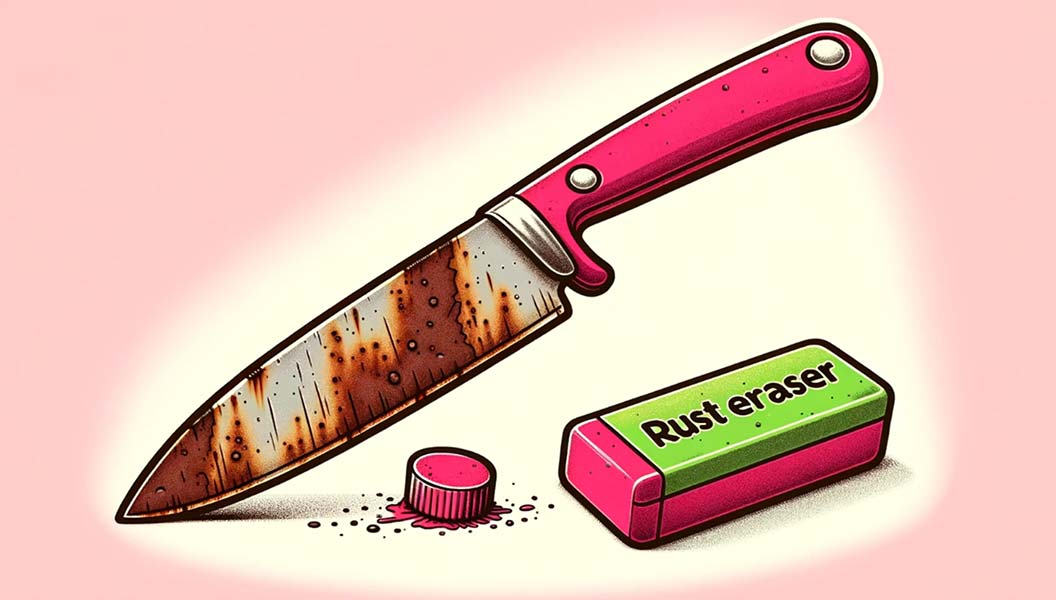
Using a rust eraser to remove rust from knives is best in specific scenarios where precision and care for the knife's surface are paramount. They are a useful addition to any kitchen because they are small, easy to use, and remove rust spots from knife blades with minimal damage to the metal.
- Prep the rust eraser by soaking it in water for 5 minutes.
- Rub the rust eraser over the rusted areas, scrubbing in the same direction as the grain of the blade of your knife.
- If the rust eraser block dries out while you scrub, set it in the water again momentarily.
- Wipe the knife blade clean, wash with dish soap, rinse, and dry fully before storing.
Rust erasers are particularly useful for knives made from carbon steel, which tends to rust more easily than stainless steel. They're also effective for removing rust and patina, which can sometimes form on carbon steel knives.
When using a rust eraser, following the product's instructions carefully and using gentle, consistent strokes to avoid damaging the knife is crucial. After rust removal, always clean and dry the knife thoroughly to prevent future rusting.
Removing Rust Using Citric Acid
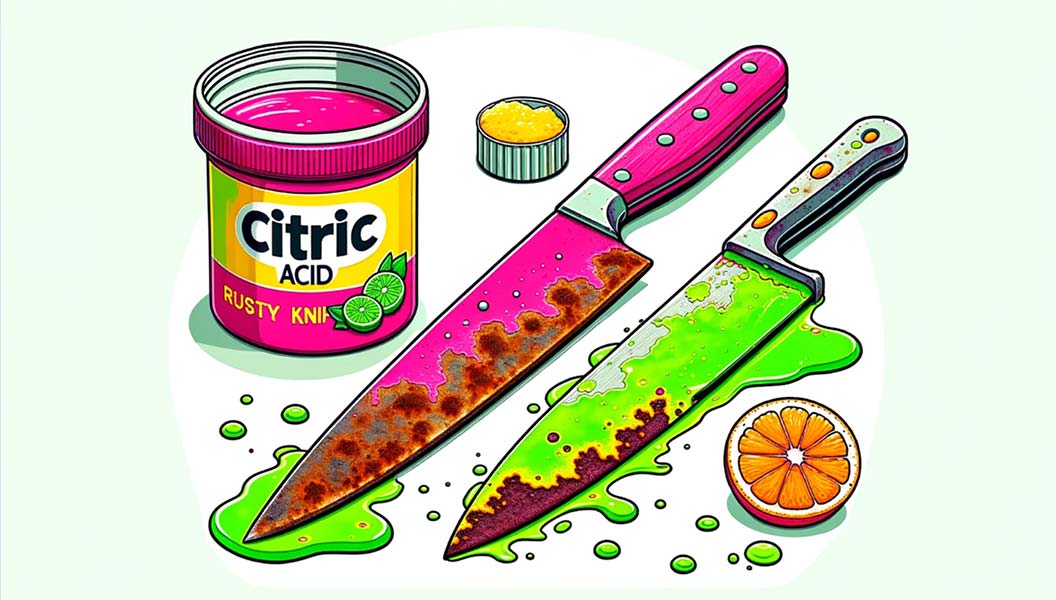
Using citric acid solution to remove rust from knives is best under certain conditions due to its effective rust-removal properties and relative safety compared to harsher chemicals. Citric acid is a great rust remover for stubborn rust. If used correctly, it can penetrate and dissolve rust effectively without damaging the underlying metal. Here is how to do it:
- When making the baking soda paste, use lemon juice instead of water.
- Alternatively, cut a lemon in half and sprinkle it with baking soda.
- Rub either the baking soda paste or the cut lemon on the rusty knife.
- Wash the knife with dish soap, rinse it, and dry it with a towel for storage.
When using citric acid, it's important to thoroughly rinse and dry the knife afterward to prevent any citric acid residue from remaining on the metal, as this could cause further corrosion over time. Additionally, while citric acid is effective for many rust removal tasks, severe rust or valuable knives might require professional treatment to avoid damage.
Removing Rust Using Vegetables
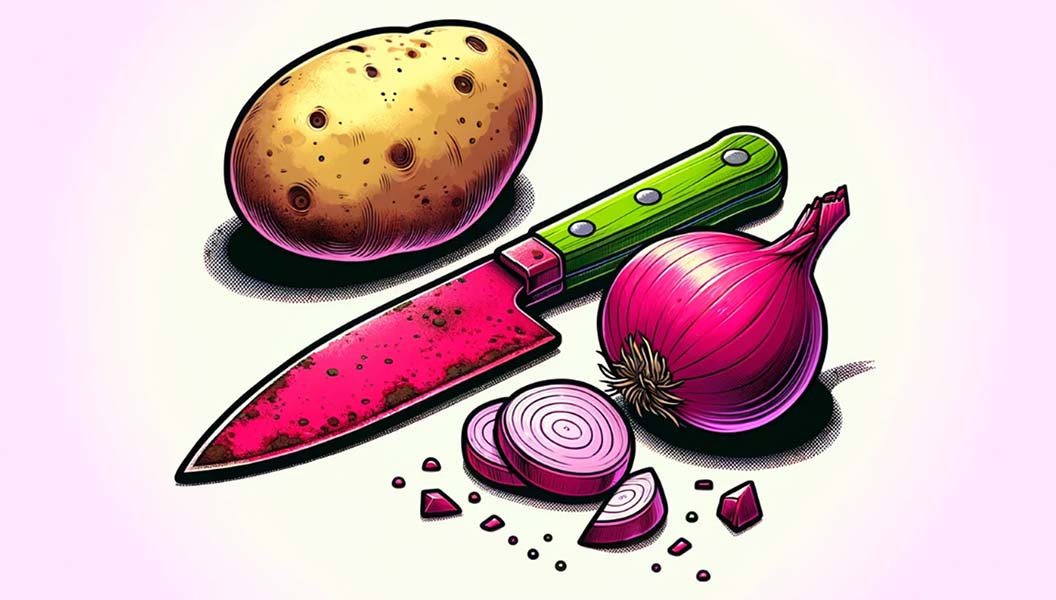
This method is surprising in its effectiveness! Using vegetables to remove rust from knives is best when looking for a natural, eco-friendly method, especially for mild to moderate rust. The potato method uses the natural oxalic acid found in potatoes to eat away at the rust spots. Onions also serve the same purpose, using sulphonic acid.
- Stab the rusted blade of your knife into either a potato or onion. Ensure that the vegetable covers all of the rust stains.
- Leave the knife in the vegetable overnight.
- Remove the knife the following day, scrub with dish soap and a soft sponge, rinse, and dry fully before storing.
Remember, it's important to thoroughly clean and dry the knife after using any vegetable-based method to prevent further rusting. For severe rust or if the knife is valuable, consider professional methods to avoid potential damage.
Removing Rust Using Vinegar
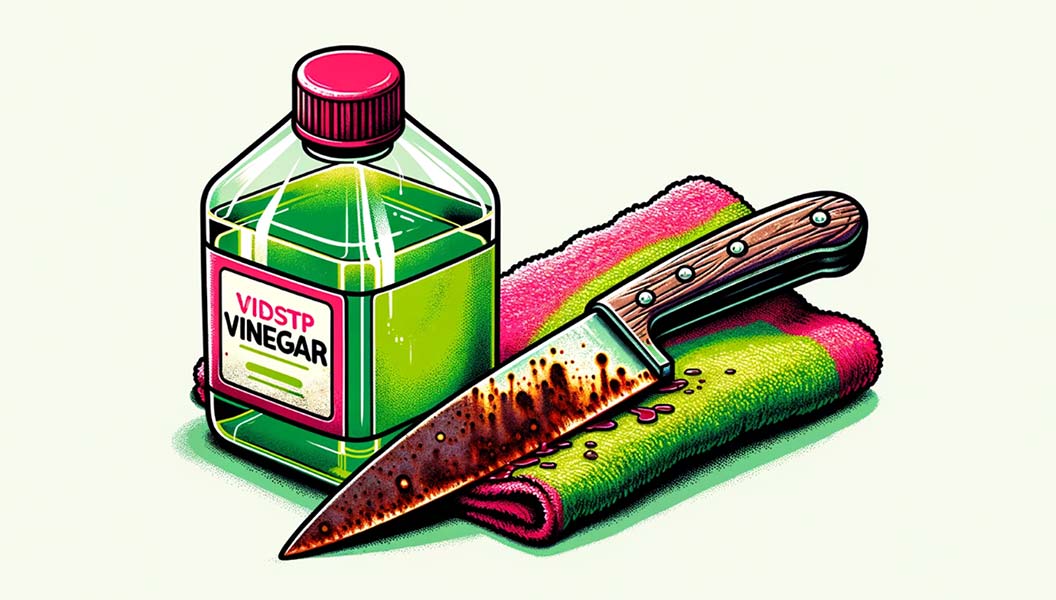
Using white vinegar to remove rust from knives is most effective for light to moderate rust. White vinegar, being acidic, can help dissolve rust without the need for harsh chemicals. White vinegar is suitable for stainless steel knives with no special coatings that could be damaged by acid. It's important to check if your knife has any specific care instructions that might advise against using acidic solutions. Here is how you do it:
- Submerge the knife blade in white vinegar. This is perhaps best done by filling a tall cup with vinegar and setting the knife inside it or using a tray.
- Let the knife soak in the vinegar for at least 5 minutes.
- Rub down the knife with a clean rag, wash using dish soap, and dry fully before storing.
It's essential to rinse and thoroughly dry the knife after treating it with vinegar to ensure no acidic residue remains that could damage the knife over time. Also, consider professional restoration for knives with severe rust or valuable knives to avoid potential damage from DIY methods.
Remove Rust Using Lemon
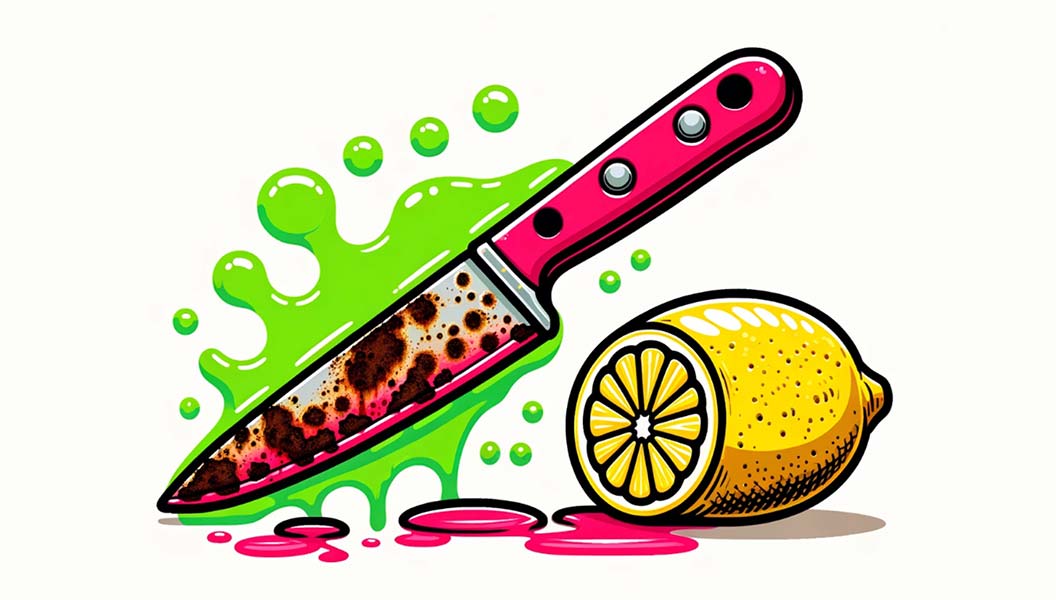
Using lemon to remove rust from knives is best suited for light to moderate rust cases. If used correctly, lemons' natural acidity can effectively break down rust without damaging the metal. Here is how you do it:
- Squeeze fresh lemon juice into a container. If you use bottled lemon juice, pour it into a small bowl. You can also cut a whole lemon in half and squeeze the juice onto the rusted areas.
- Soak a soft cloth or sponge in the lemon juice, or apply it directly to the rusty sections of the knife by squeezing it.
- Take a cloth or sponge and delicately scrub the rusted areas. The natural acidity of the lemon juice will begin to dissolve the rust. You can apply a small quantity of baking soda to the affected areas for more stubborn rust. Baking soda serves as a gentle abrasive, further aiding the rust-removal process. Keep scrubbing gently until the rust is gone.
- Thoroughly rinse the knife under a stream of running water to eliminate any traces of lemon juice or baking soda residue. Examine the knife closely to confirm if all the rust has been eradicated. If not, it might be necessary to repeat the process.
- After removing the rust, dry the knife with a clean cloth to prevent any remaining moisture from promoting future rust.
Remember, after treating your knife with lemon juice, it's important to thoroughly rinse and dry the knife to prevent any lemon juice from remaining on the metal, which could potentially cause damage over time. Additionally, while lemon is effective for light to moderate rust, you might want to consider professional sharpening or rust removal methods for heavy rust or valuable knives to avoid damaging the knife.
Methods To Avoid Using To Remove Rust
It is frequently recommended to use various harsh chemicals, such as WD-40 or mineral oil, to remove rust from knife blades. Although these cleaning solutions are effective, they are highly toxic if ingested. Never use them to remove rust stains from kitchen knives or any knives you intend to use to prepare food.
What Causes Rust Stains On Kitchen Knives?
A chemical reaction between the iron in the blade of your knife and the oxygen and moisture in the air around it causes rust stains. This process results in the formation of reddish-orange iron oxide, commonly known as rust!
Material
Certain blade steels exhibit a higher susceptibility to rust compared to others. Knives are generally crafted from two main categories of metals: carbon steel and stainless steel.
Carbon Steel - Carbon steel knives are made from steel reinforced with additional carbon. Frequently, other metal alloys are added. These blades are very strong and durable, but the higher carbon content makes them more prone to corrosion.
Stainless Steel - Stainless steel knives contain chromium, creating a strong oxide layer on the blade's surface. This prevents oxidation and rust, so this type of steel is called "stainless." However, even stainless steel blades can rust if not maintained properly!
Moisture
Water is a key component in the rusting process. When knives are exposed to moisture, whether from washing, humidity in the air, or contact with wet ingredients during food preparation, it can initiate a rusting reaction.
Acids And Salts
Certain foods, particularly those with acidic or salty properties, can accelerate the corrosion process. For instance, cutting tomatoes or citrus fruits with a high-carbon knife and leaving them unwashed can lead to rust stains due to the acidic juices promoting oxidation.
Washing In A Dishwasher
Dishwashers expose knives to a harsh environment with high heat and strong detergents. This can strip away protective coatings and contribute to rust formation, especially on knives with wooden handles.
Improper Storage
Storing knives in a humid or damp environment, such as a closed drawer, a damp kitchen towel, or a sink filled with water, can create the perfect conditions for rust to develop.
Maintaining Knives To Prevent Future Rust Stains
Even the highest-quality kitchen knife can become rusty if not maintained properly. The following maintenance steps will help prevent rust stains from developing on your knives.
Never Use The Dishwasher
Using dishwashers to clean knives causes them to lose their edge and creates an environment where hot moisture sits on the knife for an extended period.
Keep Knives Clean And Dry
Always wipe down a knife with a damp cloth after using, and then dry it thoroughly and immediately. Neither food residue nor water should be allowed to sit on the knife blade!

